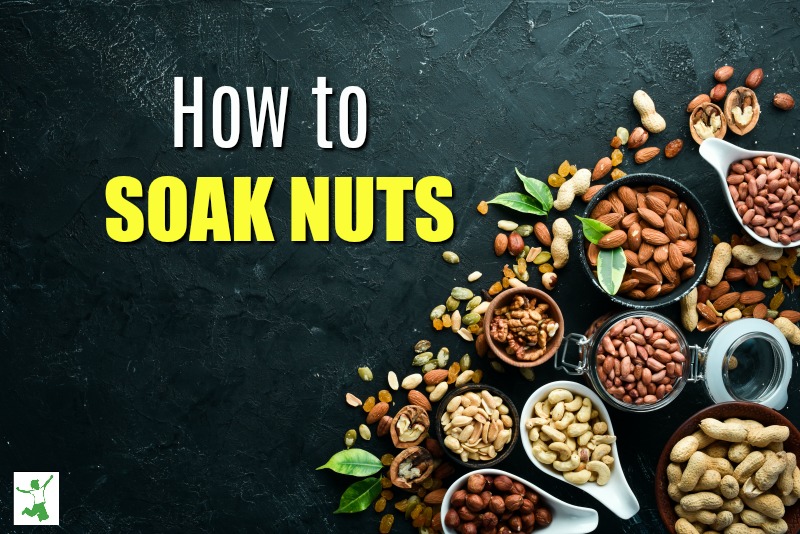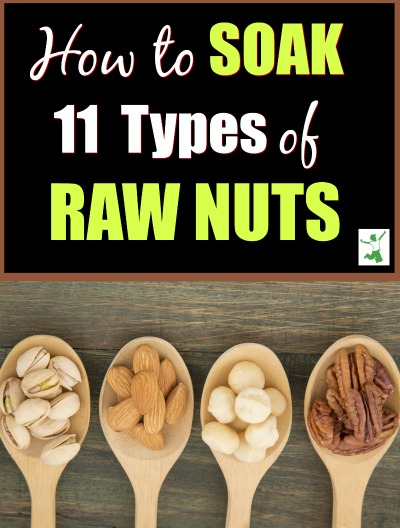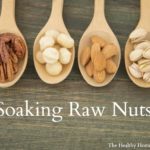
Raw nuts are one food that everyone seems to agree are very healthy to eat!
Whether you are vegan, vegetarian, Paleo or someone who eats the standard American diet of burgers and fries, raw nuts are one food that all acknowledge is a good addition to the diet. Here’s where the agreement about raw nuts ends.
The problem is that most people don’t know that soaking raw nuts first before eating them is very important. Soaked raw nuts are far more digestible than plain raw nuts. The soaking process eliminates anti-nutrients and improves nutrition while still maintaining rawness. Note that soaking does not eliminate the high amount of oxalates in nuts, however.
Raw Nuts are Seeds
While raw nuts are an extremely nutritious food, preparation is key in order to unlock maximum nutrient potential. Careful soaking deactivates any substances that could be irritating to the gut. The soaking process followed is in accordance with the wisdom of Traditional Cultures.
This is because raw nuts are a type of seed. Seeds require soaking before eating. The reason is because they contain anti-nutrients such as phytic acid and lectins that can prevent all that wonderful nutrition from being digested thoroughly.
These inhibitors can also cause digestive distress if many raw nuts are consumed. For some people, even a few raw nuts cause digestive distress. Sometimes, eating plain raw nuts can cause a rash around the mouth.
Benefits of Soaking Nuts
Deactivation of the anti-nutrients in all nuts is accomplished through sprouting or soaking. Soaking raw nuts in saltwater for a few hours and then drying in a warm (not hot) oven or dehydrator is all that is required.
According to Nourishing Traditions Cookbook, soaking and drying of raw nuts mimic the wise practice of the Aztecs. This culture soaked pumpkin seeds in brine and then dried them in the sun before grinding into flour or eating them whole.
Soaking nuts is a particularly helpful practice if you find raw nuts irritating to your stomach or mouth. My husband can eat soaked raw nuts with no problem. If he eats unsoaked raw nuts, however, he frequently experiences digestive issues and sometimes irritation around the mouth.
The anti-nutrients in raw nuts really bother some people. Even if you have no symptoms, you are likely not absorbing their wonderful nutrition as well as you could.
How Many per Day to Eat?
While extremely nutritious, it is best to keep the amount of soaked raw nuts consumed each day to a closed handful at most. This is in keeping with the recommendation of Dr. Kellyann Petrucci ND, author of the Bone Broth Diet. The reason is that most nuts contain an abundance of polyunsaturated fats, which are easily overconsumed. Too many polyunsaturates in the diet can contribute to inflammation and weight issues.
The one exception to this is macadamias. These nuts that are native to Australia contain mostly saturated and monounsaturated fats and an extremely small amount of polyunsaturated fats per serving.
By the way, if you’ve ever wondered how nuts rank nutritionally, the linked article provides the breakdown of the healthiest to unhealthiest types of nuts.
Where to Buy Quality Soaked Raw Nuts and Nut Butters
Don’t have time to soak and dry raw nuts yourself?
Yes, it is a bit time-consuming!
Check out my shopping guide for quality suppliers of soaked nuts and nut butter. We use 4-5 jars of soaked nut butter in our home every single month. Our family favorites are soaked pecan butter, soaked macadamia nut butter, soaked hazelnut butter, soaked almond butter, and soaked 4 nut blend.
How to Soak Raw Nuts
If you like to eat raw nuts whole, soaking them yourself first is very easy! Below is a recipe on how to soak the 10 most popular raw nuts followed by a video demonstrating the basic process.
Note that the process described below does not apply to a foraged superfood such as acorns. This type of nut requires an extended soaking of up to a week as practiced by Native Americans to properly remove the bitter tannins before drying and eating.
In the video below, I demonstrate how to soak raw almonds and dry them in your oven to greatly improve nutrient absorption, reduce gastric distress. You will be amazed at how soaked raw nuts taste far better than unsoaked raw nuts!
The same process can be followed for macadamia nuts, pecans, brazil nuts, peanuts, etc. The video on soaking raw nuts included with the recipe below shows how easy the process is!
Soaking Cashews
Note that soaking cashews is a bit different. This is because raw cashews from the store are not really raw.
They are heat-treated twice by manufacturers to release and remove a toxic oil between the inner and outer shell.
What to Do with Soaked Almonds?
When you make your first batch of soaked almonds, try this easy recipe for blueberry almond milk!
Blend 1 cup soaked almonds, 3 cups filtered water, 1 tsp vanilla extract, and 1/4 cup blueberries. Serve and enjoy!


Soaked Raw Nuts Recipe
The process of soaking raw nuts to improve digestibility and eliminate anti-nutrients.
Ingredients
- 4 cups raw nuts preferably organic
- 1 Tbl sea salt
- filtered water
Instructions
-
Place raw nuts in a large glass bowl (I use this one).
-
Add enough filtered water to cover.
-
Stir in sea salt.
-
Leave uncovered on the counter for 8 hours or overnight for almonds, European almonds, pecans, hazelnuts, pili nuts and macadamias.
Soak no more than 3 hours for cashews, and no more than 4-6 for walnuts, peanuts, pistachios and brazil nuts (else they will get moldy and/or slimy).
Do not mix raw nuts while soaking. You may mix while dehydrating.
-
Drain water completely.
-
Dry in a warm oven no hotter than 150 F/ 66 C until dry. If your oven can't be set that low, use a food dehydrator (I like this one). Dry soaked cashews in a 250 F oven.
-
Store crispy nuts in airtight containers in the refrigerator or cool, dark pantry.
Recipe Video
Recipe Notes
Do not mix different types of raw nuts together when soaking. Soak almonds separate from cashews, for example. This minimizes chances for mold developing. Also, the soaking times for various nuts are different.
Instead of soaking peanuts, this traditional boiled peanuts recipe is an option too.








Hi Sarah,
I’m currently travelling and so I don’t have a dehydrator or an oven. How about if I JUST soak them overnight? Is that still a positive step towards getting the maximum nutrients possible?
Yes, but they will mold quickly if you don’t dehydrate them.
Hi Sarah, Do you have a book with all of your recipes or would I purchase the”Nourishing Traditions” to get the recipes? I know you have the utube shows but I wish it was written so I don’t have to try to write everything down. Thank you for all you do! Respectfully, Mary Call (Utah)
Hi Sarah,
I love your videos and information on your blog! It is great to have you demonstrate how to do these things for those of us who haven’t done these things before. I saw your video about soaking nuts, something I also do now. Why is the salt added to the water for soaking nuts? Is it killing any germs or bacteria, or what? Do the nuts, if kept whole while soaking, sprout? I understand sprouting nuts makes them even more nutritious, like soaking grains. Is that true? Do the nuts sprout while soaking overnight?
Thanks again for a great, informative site!
In order for a seed to germinate, it has to take in water. If the SALT concentration is too high around the seed, it will actually prevent germination by keeping water from it. If it does take in the salt water, once it sprouts, it will immediately DIE. The water evaporates from the sprout and leaves the salt behind drying it out and KILLING it.
So please can someone tell me why on earth it is nescessary to soak nuts in SALT water? Does the rain water the gardens of the earth with salt water? No. I mean the nutrient content increases a thousand fold in SPROUTED nuts especially if you just soak them in freshly changed UNSALTED water for two days, after this they are sweet/milky and have a little white tip on the end. I personally take the skins off before I eat them which makes them easier to digest, and I assume it is the skins which are left with most of the anti-nutrients, oxalic acid, etc. Soaking is the same deal with legumes. Also, the best nuts and legumes for sprouting are FRESHLY dried ones because they sprout the quickest and have generally lower amounts of natural anti-nutrients (nature’s preservatives). For example dried kidney beans turn rock hard, the longer they are stored to protect them against bugs or rancidity.
I have been looking for a post like this for a LONG time, trying to figure out if using salt for the water is really necessary. I have been soaking my nuts for just under a year now and have been using salt, but I question whether it really changes the germination process. Most blogs say the same thing, how it aids in deactivating enzyme inhibitors and activating important nutrients – do we know this for certain? I’m not sure. I have also read that in the past, people have used sea water to germinate nuts, seeds and legumes which could be where this idea comes from. May I ask, where did you learn about rain water and sprouting? Thanks.
What about Hazelnuts? How long do you process them? you have not mentioned this particular nut above.
thanks
Hi Sarah,
I see a few questions about mold and aflatoxin in peanuts, but no response. I would love your thoughts on this and to know if you have any good source to buy peanuts to avoid this.
Thanks
I don’t know if you’ve ever heard of Organic Raw Jungle Peanuts before, but they have very little aflatoxins if any at all. Try Znaturalfoods.com or Nuts.com. I hope this helps.
Hi there – I have been soaking my nuts, but hadn’t yet heard of doing it in salt water. I see that before you dry them, you don’t rinse them. I thought that was a must. I make my own almond milk, do I need to dry them first? Thank you.
Sarah,
Back in July Pat posted the following “Sarah, please tell me where you found this info. I would like to read it as I find this facinating. I have always been taught that any raw food that is heated above 115F kills the enzymes”
You never replied and I also am interested where you found this info.
Dan
I would also like to know where Sarah obtained her information about 150 degree ovens not destroying the enzymes. I’ve always believed anything over 118 degrees was not good. . . . I’ve read through all of the comments and have not found a reply from Sarah about this. . . .
Jodie, 118F limit is for wet heat … dry heat can be higher than 118F with enzymes still preserved. Think about Arizona summer heat … it can be 120F outside and we are still alive, right?
Should the hazelnuts have their skins peeled of? How were hazelnuts prepared by traditional people?
How long should hazelnuts be soaked? Is it the same as almond? Thanks.